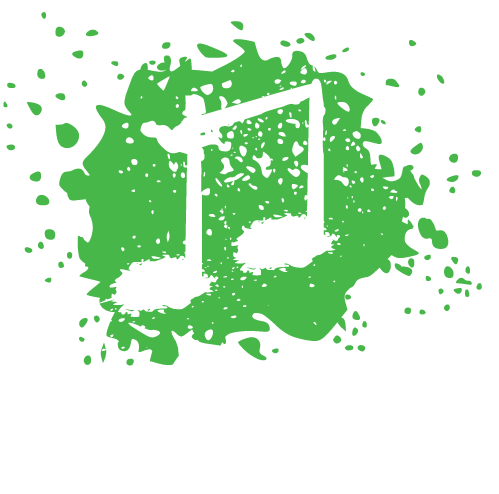How to Read Drum Notation for Beginners
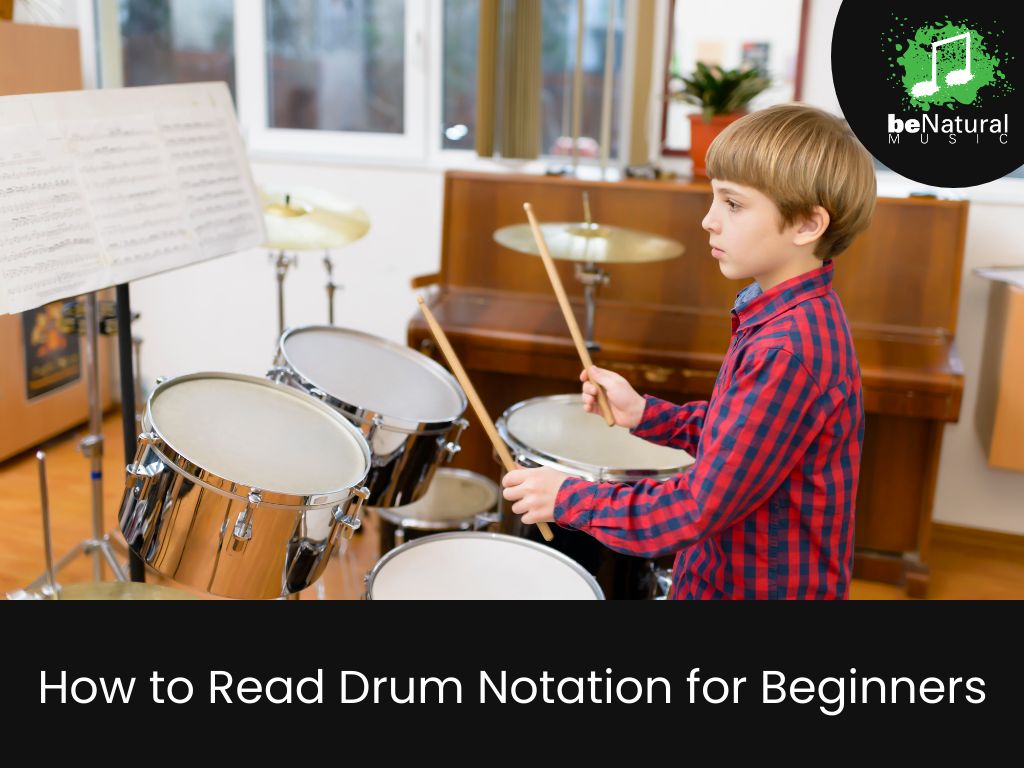
Think drummers don’t need to read sheet music? Think again!
Sure, some drummers can get by without knowing how to read music professionally. However, learning to read drum sheet music opens up a world of possibilities for drummers of all skill levels.
Whether you are interested in improving your skills as a working musician or for the health benefits of drumming, learning to read drum sheet music is a worthy goal.
Read on to learn the basics of how to read drum sheet music, as well as what you can achieve by obtaining this skill.
What is Drum Notation?
Drum notation is slightly different from sheet music used for other instruments, although they look similar and follow similar concepts.
In traditional sheet music, the symbols on the staff represent specific notes. Conversely, the symbols found on drum notation represent which part of the drum to play, such as the hi-hat, bass drum, or snare.
Drum notation can be challenging to read at first but becomes pretty simple if you break it down and learn the basics in the right order.
The Basic Components of Drum Sheet Music
Learning how to read drum notation starts by understanding the basic structure of written music. The components of sheet music are taught in great detail in almost all types of music lessons, but here’s a quick overview:
The Staff
Like the notation for other instruments, drum notation is written on a series of five horizontal lines known as the staff. Each line and space on the staff correlate to a specific note (pitch) or instrument.
For drums, each line and space of the staff are assigned to a different part of the drum set – so you can tell everything apart. A key or legend will usually be placed at the beginning of a piece providing specific information about which part of the drum set is represented by each line and space.
Example of a drum legend:

In general, lower pitches (like the floor tom and bass drum) are usually towards the bottom of the staff, while toms and snares are in the middle. Higher tones (like cymbals) are often towards the top.
The Drum Clef
A drum clef is a symbol placed at the beginning of a piece of written music that tells you that the music is specifically made for drums. It’s illustrated by two bars starting at the second line of the staff and ending at the fourth.
So, when you see this symbol:
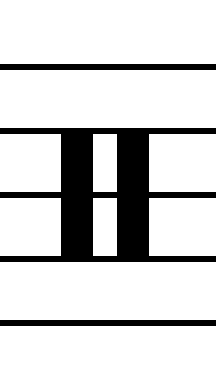
You know that it’s drum sheet music!
Time Signature
The time signature is another important piece of information found at the beginning of drum sheet music. It comes right after the drum clef and is represented by two numbers written horizontally.
Written music is divided into measures (or “bars”), containing a specific number of beats. The top number in the time signature tells you how many beats are in each measure, while the bottom number tells you the value of each beat.
For example, if you see a time signature of 4/4, that means there are four beats per measure, and each beat is worth one-quarter note. Alternatively, if you see a time signature of 6/8, that means there are six beats in each measure, and each beat is worth one-eighth note.
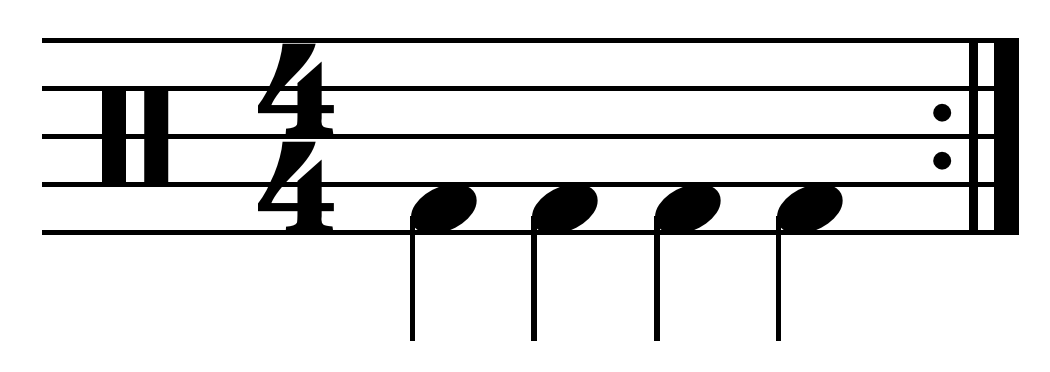
The Tempo
A tempo marking is often written in the top left corner of a piece of sheet music. It’s written in BPM and tells you how fast or slow the music should be played.
For instance, a tempo of 60 BPM at 4/4 means you should play each of the measures four-quarter notes once per second.
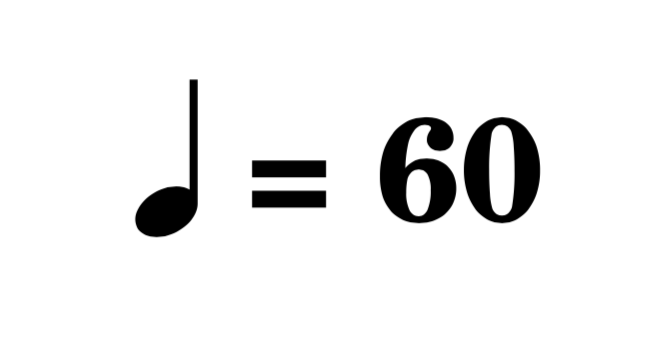
Repeat Signs for Drum Music
A repeat sign tells you to either replay a certain music section or go back to the start and repeat from there. You must know several different types of repeat signs to read drum sheet music. These include:

The Standard Repeat Sign:
Drum music is often played in patterns, which means sections are often played more than once in a row. In drum notation, a repeat sign tells you to return to the beginning of the section and play it over again.
The One-Bar Repeat Sign:
A one-bar repeat sign means you need to play the previous measure for an additional bar before moving on to the next section. This sign looks similar to the symbol that represents the percent sign. It has a small dot on either side of a diagonal line.
The Two-Bar Repeat Sign:
A two-bar repeat sign means you need to play the previous two measures before moving to the next section. It looks similar to a one-bar repeat sign, but it has two diagonal lines.
How to Read Drum Notation
Now that you have a basic understanding of how to drum sheet music is structured, it’s time to look at the notation itself.
Let’s start by discussing the two main parts of a drum note.
Components of a Drum Note:
-
The Note Head:
A note head is the round part of a note, which will be either hollow (denoting an open drum sound) or solid (representing a closed drum sound). The note head will be an “x” instead of a circle for cymbals and hi-hat notes.
-
The Note Stem:
The stem is the vertical part of a note that extends from the note head. The stem helps explain how to count the beat that is shown on the note.
Important Symbols to Learn:
Now, let’s look at some of the common symbols you will encounter when reading drum sheet music.
Drummers should know how to identify certain symbols when learning drum notation, especially when starting with a basic four-or-five-piece drum set. These include the following:
-
Bass Drum
The notation for the bass drum is written on the bottom staff line. The bass drum is the biggest drum on most drum sets and produces the lowest note. It’s typically played with a foot pedal and is sometimes referred to as the “kick drum.”
-
Floor Tom
The notation for floor toms is written on the middle staff line. Floor toms are usually doubled up with rack toms, making them sound fuller. They produce a medium-pitched note and are played using the tip of the sticks or mallets.
-
Tom 1 & Tom 2
The notation for tom 1 and 2 is written in the first space near the staff’s top. Toms are smaller drums on a drum set and produce a higher-pitched note. They are played using either the tip or side of the stick, depending on preference.
-
Snare Drum
The snare drum is considered the main drum because it’s the one drum that is usually played with both hands. Its notation is written on the second space from the top of the staff. The snare drum produces a sharp, loud sound when struck with a stick.
-
Hi-Hat Pedal
The notation for the hi-hat pedal is written on the top staff line. The hi-hat pedal keeps a steady beat and is played by foot.
-
Crash Cymbal
The crash cymbal is also written above the staff line and before any other drums on a drum set. It’s played by being struck with a stick, is very loud, and produces a sharp sound. The crash cymbal usually stands to the right of the snare drum and is often used as an accent or to emphasize certain parts of a song.
-
Ride Cymbal
The ride cymbal is similar to the crash cymbal, but it’s usually softer and produces a smooth sound. It can also be used to keep time and emphasize certain parts of the song. The symbol for the ride cymbal is written on the very top line of the staff.
How is Drum Notation Different from Drum Tablature?
Drum tablature is a simplified version of drum notation. The main difference is that drum notation does not use the typical notes you would read on sheet music. Instead, it uses a series of vertical and horizontal lines with different symbols to represent the rhythm and patterns of the song.
Beginner drummers may find that using drum tablature is easier to begin learning the basics before transitioning to drum notation. However, drum tablature can be slightly challenging to read, depending on the publisher.
There are plenty of free drum tablature resources available online that you can explore to see if it’s a good fit for you.
Techniques for Hitting the Drum
There are many ways to strike a drum, each giving off a different sound. How you grip the stick and the positioning of your hands and arms determine how you should hit a drum to produce that desired sound.
You don’t always need to strike the drum directly with the stick. Instead, there are times you might hit the drum with the stick at an angle. You can use your thumb and index finger to control the angle, direction, and amount of spin you put on the stick to produce different sounds.
As a beginner drummer, it’s crucial to know the different techniques for hitting drums so you can play specific sounds. In fact, it is one of the first things you will learn in the early stages of drum lessons.
Drum Techniques
Here are a few common drumming technique notations you may see when reading drum sheet music:
What is an Accent Drum Technique?
Accents emphasize specific notes by making them sound louder, softer, higher, or lower when struck. They can be achieved by hitting the drum harder, closer to the edge of the head, or using a different stick (i.e., snare drum and hi-hat cymbal).
Each instrument in a piece of music is typically assigned one type of accent. This helps keep track of how much emphasis should be placed on each drum hit and helps keep the song in time.
What is a Marcato Drum Technique?
The marcato technique gives drum notes a sharp, pronounced sound. This technique is written by a small arrow pointing up or down to indicate a sharp rise in volume on a particular drum note.
Typically, a marcato note should be struck slightly above or below the center of the drumhead.
What is a Ghost Note Drum Technique?
Ghost notes are an unaccented drum technique in which the very edge of the stick is used to touch the drumhead, giving off a lighter sound. They can also be called ghost tones or dead beats.
Ghost notes help keep the song in time and keep the beat of the music together.
What is a Drag Drum Technique?
The drag technique produces a softer sound.
It’s commonly seen when the hi-hat cymbal is opened and closed by sliding the stick back and forth in a continuous motion without stopping. This technique helps add more expression and color to the song, especially when paired with other drumming techniques.
What is a Rim Click Drum Technique?
A rim click is an accent that sounds like a slight bell ringing. This technique can be achieved by lightly bringing the sticks down on the drumhead, but not entirely down to strike it.
A rim click is commonly used when playing jazz or any music where subtle notes are emphasized.
What is a Flam Drum Technique?
A flam note is created by consecutively playing the same note on two different drums. It sounds like two drum notes being played simultaneously, but it is one note with a slight delay.
The symbol for the flam drum technique may differ depending on the type of music you are playing. The key at the beginning of a piece of music will typically indicate how it should be read.
Cymbal Techniques
Here are a few common cymbal technique notations you may see when reading drum sheet music:

What is a Crash Bell Drum Technique?
The crash bell technique creates a much louder and brighter sound than a normal crash. Often, drummers achieve this by striking the cymbal with the shoulder of their drumsticks.
This technique is commonly used when there is a sudden change in music volume, intensity, or at the end of a drum fill.
What is a Choke Crash Drum Technique?
The choke crash technique dampens or “chokes” a cymbal after it’s been struck.
This technique involves placing the tip of one stick on top of the cymbal, with the other stick resting on both ends of that same cymbal. This creates a shorter sound than a normal crash.
What is a China Drum Technique?
The China technique is a softer cymbal strike that produces a sound similar to a marcato noise.
You should lift your sticks high and quickly bring them down onto the cymbal to create this sound. This technique is used to add color or an accent to a song.
What is a Splash Drum Technique?
A splash cymbal creates a small, thin, very high pitch sound.
This sound can be achieved by striking the edge of the drumhead near the outer rim of the instrument. A splash should not be confused with a China cymbal, which has more depth and volume to its sound.
What is an Open Hi-Hat Drum Technique?
The open hi-hat technique is used in loud sections of music.
It’s created by taking your foot off the hi-hat pedal and then striking the hi-hat cymbals. This technique helps create bounce between the two cymbals.
What is a Closed Hi-Hat Drum Technique?
The closed hi-hat technique is used in softer sections of music. It’s created by keeping the foot on the pedal of the hi-hat cymbals before hitting it.
This technique can be heard when playing pieces that use a slow tempo.
What is a Loose Hi-Hat Drum Technique?
The loose hi-hat technique is used to produce a softer sound.
This technique involves stepping lightly on the pedal of your hi-hat cymbals and then hitting them. It creates a sound that’s similar to the hi-hat technique, but not as long.
The Wrap Up
There is much to learn about reading drum sheet music, but it can be a fun and rewarding challenge to take on. Once you have mastered it, you can pick up any sheet music and jam away!
If you are interested in taking drumming lessons, Be Natural Music offers online and in-person classes for students of all skill levels. We’ll teach you everything from the basics of reading drum notation to advanced techniques.
